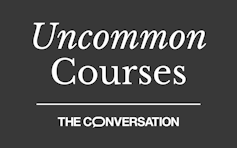This course examines the dark realities behind your favorite children’s stories


Uncommon Courses is an occasional series from The Conversation U.S. highlighting unconventional approaches to teaching.
Title of course:
“Children’s Literature”
What prompted the idea for the course?
The idea came from a book I bought at a used book sale.
It was Roald Dahl’s “Charlie and the Chocolate Factory,” but it wasn’t the version I expected.
While reading the book to my children in 2017, I discovered that in the copy of the book I had bought, Willy Wonka describes the Oompa-Loompa characters – the subservient chocolate makers in his factory – in a way that resembled the Black slave experience in the United States. Specifically, Willy Wonka says he smuggled them to his factory in crates.
“Imported direct from Africa!” Wonka says in this version of the book. “I discovered them myself. I brought them over from Africa myself – the whole tribe of them, three thousand in all. I found them in the very deepest and darkest part of the African jungle where no white man had ever been before.”
This version, which was published in 1964, did not include the changes that Dahl had made in the late 1970s at the urging of the NAACP. Dahl subsequently made the Oompa-Loompa characters’ skin “rosy-white” and their place of origin “Loompaland.”
As a parent, I was so struck by my experience reading the book to my children that, the following year in 2018, I chose to create a course that shows how children’s literature has changed over time.
What does the course explore?
We examine books from different periods in time. The texts range from the bawdy Latin plays written for medieval schoolboys to contemporary works like Jacqueline Woodson’s “Brown Girl Dreaming,” an autobiography written as a series of poems for young readers.
The course also explores how cultural biases shape people’s assumptions about what books are appropriate for children. We examine the ways race, gender, sexuality, class, ethnicity and age show up in children’s stories. We also explore shifts in capitalism, parenting, sexuality and mental illness that are reflected in texts such as “The Little Prince” and “Peter Pan.”
I ask students to define childhood, what it looks like and what its purpose is. Students’ answers tend to reflect current cultural norms, describing childhood as a time of innocence in which we learn, play and make mistakes, under the protective gaze of caring adults. But as we read the course texts, it becomes clear just how varied childhood is and has been. Time has changed what people expect childhood to look like. For instance, a 17th-century version of “Sleeping Beauty” has a king impregnating a sleeping young lady. In a 19th-century version, however, there’s no king but a prince, and no sex but a kiss.
Why is this course relevant now?
The American Library Association reports that in 2022 there were more attempts to ban books than in any previous year on record. In the course we discuss the history of censorship. Philosophers and writers such as Jean-Jacques Rousseau and Sarah Trimmer argued that fairy tales would morally corrupt children by distorting their grasp on reality. However, once realism in literature became popular in the 19th century, censors tried to protect children from the harsh reality of societal ills.
What’s a critical lesson from the course?
Near the beginning of the course we examine the fairy tales that permeate modern culture. We read multiple versions of tales like “Little Red Riding Hood” and “Cinderella” to see how these stories were rewritten over time.
Students are often surprised by the overt sexuality and violence in these early versions of tales for children. They learn that the appropriateness of a book is debatable, not fixed.
What materials does the course feature?
• Lewis Carroll’s “Alice’s Adventures in Wonderland” – one of the earliest novels written expressly for children.
• Pamela Brown’s “The Swish of the Curtain” follows a group of kids who realize their dream of performing on stage.
• Christopher Paul Curtis’ “The Watsons Go to Birmingham, 1963,” a novel with a young Black narrator who is a keen observer of his family’s struggles and joys.
What will the course prepare students to do?
My hope is that students will begin to look at children’s books in a more critical way. Many people never pick up a children’s book once they become adults, or, if they do, they are reading it to a child or for nostalgic reasons. My course is meant to get students to look at children’s books not just as sources of entertainment or enjoyment, but to better understand how those books are shaped by – and help shape – the cultural norms of the society in which we live.





